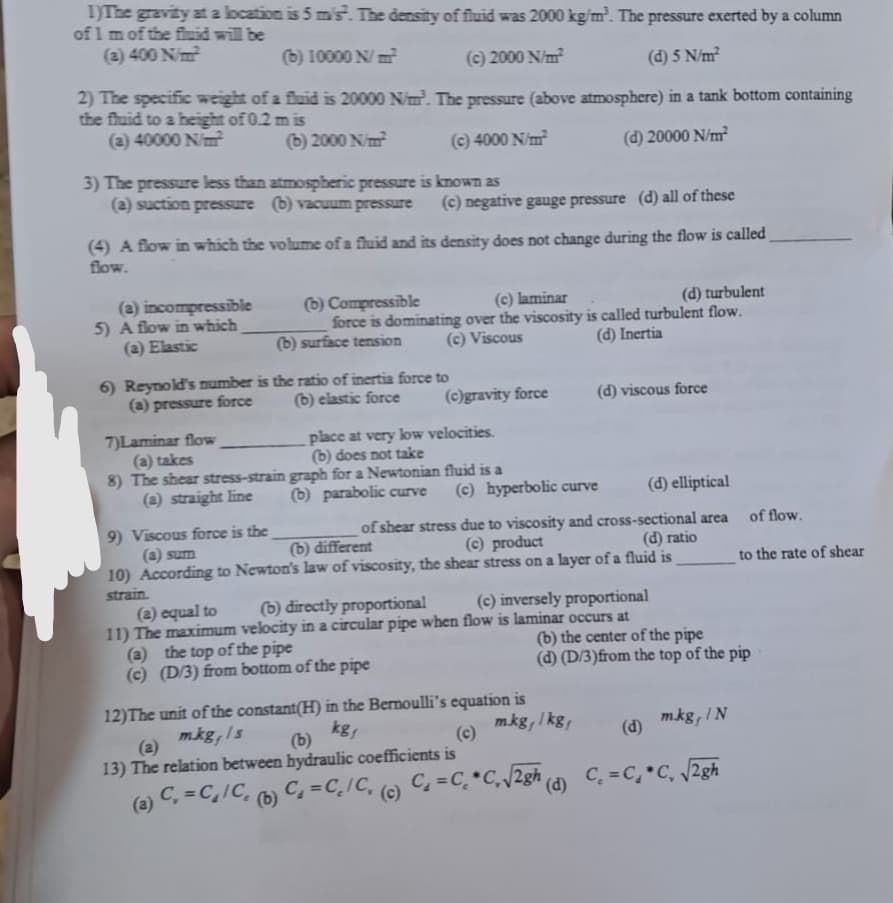(a) sum 10) According to Newton's law of viscosity, the shear stress on a layer of a fluid is strain. (a) equal to (b) directly proportional (c) inversely proportional locity in a circular pipe when flow is laminar occurs at to the rate of she
(a) sum 10) According to Newton's law of viscosity, the shear stress on a layer of a fluid is strain. (a) equal to (b) directly proportional (c) inversely proportional locity in a circular pipe when flow is laminar occurs at to the rate of she
Elements Of Electromagnetics
7th Edition
ISBN:9780190698614
Author:Sadiku, Matthew N. O.
Publisher:Sadiku, Matthew N. O.
ChapterMA: Math Assessment
Section: Chapter Questions
Problem 1.1MA
Related questions
Question
Q 10 please

Transcribed Image Text:1)The gravity at a location is 5 ms. The density of fluid was 2000 kg/m³. The pressure exerted by a column
of 1 m of the fluid will be
(a) 400 N/m²
(b) 10000 N/m²
(c) 2000 N/m²
(d) 5 N/m²
2) The specific weight of a fluid is 20000 N/m³. The pressure (above atmosphere) in a tank bottom containing
the fluid to a height of 0.2 m is
(a) 40000 N/m²
(b) 2000 N/m²
(c) 4000 N/m²
(d) 20000 N/m²
3) The pressure less than atmospheric pressure is known as
(a) suction pressure (b) vacuum pressure (c) negative gauge pressure (d) all of these
(4) A flow in which the volume of a fluid and its density does not change during the flow is called
flow.
(a) incompressible
5) A flow in which
(a) Elastic
(b) Compressible
(c) laminar
(d) turbulent
force is dominating over the viscosity is called turbulent flow.
(c) Viscous
(d) Inertia
(b) surface tension
6) Reynold's number is the ratio of inertia force to
(a) pressure force
(b) elastic force
7)Laminar flow
(a) takes
8) The shear stress-strain
(a) straight line
(c)gravity force
place at very low velocities.
(b) does not take
graph for a Newtonian fluid is a
(b) parabolic curve
(c) hyperbolic curve
(d) elliptical
9) Viscous force is the
(a) sum
(b) different
of shear stress due to viscosity and cross-sectional area
(c) product
(d) ratio
10) According to Newton's law of viscosity, the shear stress on a layer of a fluid is
strain.
(a) equal to
(b) directly proportional
(c) inversely proportional
11) The maximum velocity in a circular pipe when flow is laminar occurs at
(a) the top of the pipe
(c) (D/3) from bottom of the pipe
12) The unit of the constant(H) in the Bernoulli's equation is
mkg, Is
kg,
(a)
(b)
13) The relation between hydraulic coefficients is
(a) C₁ = C₁/C₂ (b) C₁=C₂/C, (c)
(d) viscous force
m.kg,/kg,
C₁=C₂ *C₁ √2gh (d)
(b) the center of the pipe
(d) (D/3) from the top of the pip
m.kg, IN
of flow.
(d)
C₁=C₁ C₁ √2gh
to the rate of shear
Expert Solution
This question has been solved!
Explore an expertly crafted, step-by-step solution for a thorough understanding of key concepts.
Step by step
Solved in 2 steps with 1 images

Knowledge Booster
Learn more about
Need a deep-dive on the concept behind this application? Look no further. Learn more about this topic, mechanical-engineering and related others by exploring similar questions and additional content below.Recommended textbooks for you

Elements Of Electromagnetics
Mechanical Engineering
ISBN:
9780190698614
Author:
Sadiku, Matthew N. O.
Publisher:
Oxford University Press

Mechanics of Materials (10th Edition)
Mechanical Engineering
ISBN:
9780134319650
Author:
Russell C. Hibbeler
Publisher:
PEARSON

Thermodynamics: An Engineering Approach
Mechanical Engineering
ISBN:
9781259822674
Author:
Yunus A. Cengel Dr., Michael A. Boles
Publisher:
McGraw-Hill Education

Elements Of Electromagnetics
Mechanical Engineering
ISBN:
9780190698614
Author:
Sadiku, Matthew N. O.
Publisher:
Oxford University Press

Mechanics of Materials (10th Edition)
Mechanical Engineering
ISBN:
9780134319650
Author:
Russell C. Hibbeler
Publisher:
PEARSON

Thermodynamics: An Engineering Approach
Mechanical Engineering
ISBN:
9781259822674
Author:
Yunus A. Cengel Dr., Michael A. Boles
Publisher:
McGraw-Hill Education

Control Systems Engineering
Mechanical Engineering
ISBN:
9781118170519
Author:
Norman S. Nise
Publisher:
WILEY

Mechanics of Materials (MindTap Course List)
Mechanical Engineering
ISBN:
9781337093347
Author:
Barry J. Goodno, James M. Gere
Publisher:
Cengage Learning

Engineering Mechanics: Statics
Mechanical Engineering
ISBN:
9781118807330
Author:
James L. Meriam, L. G. Kraige, J. N. Bolton
Publisher:
WILEY